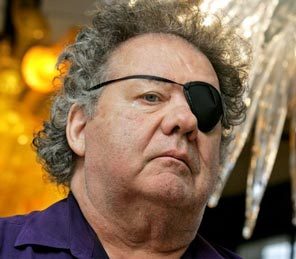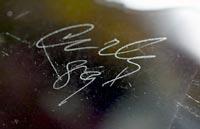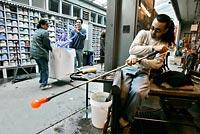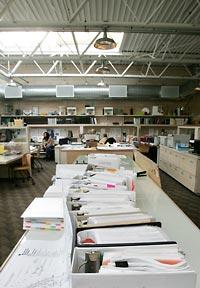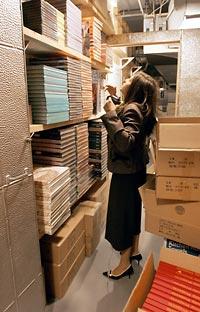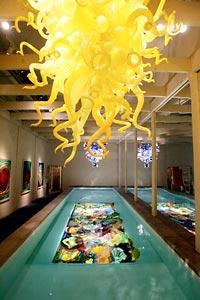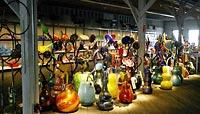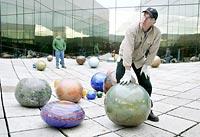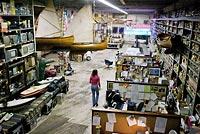 |
|
|
|
|
|
|
Thursday, April 29, 2010 - Page updated at 02:44 PM Inside the glass empireSeattle Times staff reporters
If we measure an artist's importance by the number of museum exhibitions, books, articles and television appearances he has, Seattle glass guru Dale Chihuly is right up there with the greats. His work is in the collection of most every U.S. art museum you can think of, as well as many abroad. Museum exhibitions of his work circulate continually and stacks of hefty coffee-table books praise his talents. And who hasn't seen one of those often-aired documentaries about him on PBS? But what many don't know is that Chihuly — a Northwest icon who has built a multimillion-dollar business — generates the bulk of that exposure himself. Most of those hugely popular exhibitions weren't organized and distributed by art museums, but by Chihuly Inc. And those books and television shows? Most of them were produced by Chihuly's publishing company, Portland Press. All that publicity has inflated the public notion of Chihuly's status in the art world. "It's not different from the model," says Chihuly's friend and former collaborator, Jamie Carpenter, an acclaimed New York designer. "It's just self-perpetuated." In fact, the audacious and charismatic Chihuly has always played by his own rules. Most galleries require exclusive rights to an artist's work within a certain region. Chihuly rejects that convention, competing with the many galleries that represent him by selling directly from his studio and through independent sales agents. The glass artist is known for his generosity, but instead of making straight donations he often gives in a way that benefits him, too. He cultivates customers — and sells work at "special prices" — through nonprofits, including one he established. He's known for promoting glasswork as fine art, yet produces it on a factory scale, with teams of craftsmen and contractors turning out warehouses full of glass components. And though Chihuly no longer blows glass himself, he is ever vigilant about what other glassblowers are making, intimidating those whose work he deems too much like his trademark style. Of course, Chihuly, 64, isn't the first artist known for showmanship and self-promotion. He's been likened to Salvador Dali, Jeff Koons and Andy Warhol. Another name pops up repeatedly, too: Thomas Kinkade, the controversial Christian "Painter of Light" and founder of a shopping-center art franchise business. "Kinkade has a factory to produce the work, operating with a staff of painters and touch-up people, and with marketing people who control their own outlets," said Portland Art Museum curator Bruce Guenther. "That's a model built off Dale Chihuly."
But now even Chihuly — a man known for his extremes — may finally have taken a successful formula too far. Last year, he filed a lawsuit against a local entrepreneur and a glassblower who once worked for him, claiming they had copied his work. In so doing, he laid open his business to a level of public scrutiny it has never before had. Counterclaims filed against Chihuly, alleging he's not involved in designing or even signing a "substantial number" of works of art that bear his name, threaten to undermine his integrity and his companies' reputation. Chihuly and the glassblower, Bryan Rubino, were negotiating a possible settlement last week, but a premature announcement of the deal by Chihuly put the talks in jeopardy, Rubino's lawyer said. Entrepreneur Robert Kaindl says he has no plans to settle. The media have eagerly jumped into the controversies. The Stranger, Seattle's in-your-face alternative weekly, started it off with a cover story, "Glassholes/The Trials of Dale Chihuly," that lambasted him as a glass "celebrity," not a glass artist. The Seattle Post-Intelligencer countered with a sympathetic look suggesting Chihuly had been "victimized by his own success" and his struggle with bipolar disorder. A front-page article in The New York Times took a straight-on look at the lawsuit and Chihuly, repeating often-told stories about him. Chihuly and his forces have responded with a public-relations blitz: press invitations to the studio, public appearances, TV and radio interviews and a slate of August exhibitions and events in Seattle and his hometown, Tacoma. Yet beyond all the fanfare and P.R. lies a deeper story about the creation of the Chihuly brand, the corporation's aggressive efforts to defend it, and even the artist's much-touted affiliation with charities. The marketing machine On the other side of an unmarked security door in an undistinguished Ballard warehouse, you can glimpse the soul of a multimillion-dollar business empire. In something akin to a war room, a map of the United States displays clusters of pushpins, spreading from coast to coast. Shelves filled with three-ring binders line the walls. This is corporate headquarters for Chihuly Inc. The pushpins represent the locations of Chihuly's U.S. sales force. The binders, research on past, present and future targets. City by city, country by country, Chihuly's Napoleonic marketing campaign has created a luxury market for art glass unmatched since the glory days a century ago of Louis Comfort Tiffany lamps and vases. Since 1993, Chihuly has self-published more than 20 lavish coffee-table books about himself and has expanded into production of videos about his work, prints, T-shirts, postcards, calendars, carry-on totes and glass collectibles. Chihuly's "documentaries" — broadcast repeatedly on public television with sales promotions of his books and artwork — are essentially infomercials. Clearly, Chihuly didn't get to be the world's foremost impresario of art glass by sitting back and waiting for things to happen. Former Seattle Art Museum curator Patterson Sims, now director of the Montclair Art Museum in New Jersey, affectionately sums up his friend as a charismatic and yet "completely anal ... control-freak person." Sims organized Chihuly's breakthrough exhibition "Chihuly Installations," which attracted big crowds for SAM in 1992. Chihuly took it from there. He packaged the show and rented it to venues around the country. For museums, organizing a traveling show can be difficult. Institutions typically borrow artwork from artists, other institutions and private collectors, who worry about loss or damage to irreplaceable objects. Often, owners place restrictions on where and when the work can be displayed. Chihuly doesn't have to worry about that. If something breaks, his studio makes another. "That's one of the reasons why I had so many museum shows. We'll put together a show, and I'll own it, and we'll travel it sometimes up to 15 museums," Chihuly said. Initially, some shows were offered free. Now more elaborate exhibitions rent for as much as $500,000. Museum directors are usually happy to pay, because the Chihuly name helps generate high attendance. But even if Chihuly doesn't charge for the exhibition, the high-profile exposure brings him additional sales of glass, books and gift-shop items — and might even get him into the museum's permanent collection. It's a circular kind of marketing that serves both the institutions and Chihuly. Over the years, he has expanded his territory from galleries and museums to casinos, resorts and now his latest venue: botanical gardens. The installations keep getting bigger and more elaborate. For him, it's an unbeatable formula, rooted in a 1996 project that helped make him one of the best-known living artists in America: "Chihuly Over Venice." Chihuly and his crew placed 14 outdoor chandeliers in sites around the Italian city, followed by an entourage of photographers, glassblowers and groupies, including former PBS "Frugal Gourmet" host Jeff Smith and former Texas Gov. Ann Richards. The project was filmed by KCTS, and the now-legendary high-definition production, first broadcast in 1998, has since shown repeatedly on PBS stations around the country. "That's what really pushed things over the edge scalewise," said Chihuly's friend John Landon, who helped facilitate the massive and complicated Venice project. "That's when we knew we could do anything." Chihuly's team had cooked up the event and overcame serious reluctance on the part of Venetian authorities to make it happen. The team also filmed its own documentary. To finance the project, Chihuly turned to Missouri banker and art patron R. Crosby Kemper Jr., who said his foundation gave Chihuly "several hundred thousand dollars." In exchange, Chihuly promised the Kemper Museum first booking for the exhibition "Chihuly Over Venice." He also gave three major works of art to the museum's permanent collection. Chihuly's deal with Kemper was not unusual for the glass artist. Connie Sequin, his accounting manager at the time, said Chihuly had a way of raising money in a pinch. "He'd pick up the phone and call someone he knew and give them a vision of something — maybe an installation — to cut the money loose. The next day he'd have a hundred grand in his hand, and we'd be rolling." Building a brand Chihuly never stood out as an exceptional glassblower. What set him apart, says friend and colleague Kate Elliott, "was his energy, his ability to motivate everybody, and charisma. He was just unstoppable, really." As an artist, Chihuly has always been a scavenger of images and ideas. He's known for translating forms and patterns from nature and other media into glass: the designs of Native American blankets, the undulating shapes of sea creatures, the orbs of Japanese glass floats. "He borrowed from the past and made it his own," said Michael Monroe, director of the Bellevue Arts Museum. Monroe gave Chihuly's career a boost in 1978, when as curator of the Renwick Gallery, the craft arm of the Smithsonian Institution in Washington, D.C., he picked Chihuly for a solo show. At that time, the Renwick was known for showing only top craftspeople who were famous or dead — but that didn't intimidate the upstart glass artist. When he found out Monroe didn't have money to publish a catalog for him, Chihuly took over. "He had this grand way of thinking," Monroe recalls. The artist bartered glass for services to get the catalog done — a method of doing business he's still known for. Monroe remembers Chihuly showing him a set of professional color transparencies and vowing: "I'm going to get these pictures in every publication I can, because more people will see my work in this way than in any exhibition." When it came to sales, Chihuly had an equally aggressive attitude. Elliott, who worked for Chihuly in the 1970s and '80s, remembers their conversation when an Arizona craft gallery couldn't sell a batch of glass cylinders. Chihuly looked at the prices and came up with a startling solution: "I bet if I add a zero to that they will get some respect." The higher prices helped push his work into the realm of fine art rather than craft — paying off brilliantly for Chihuly and eventually for others, too. A leader of the studio glass movement and co-founder of Pilchuck Glass School in Stanwood, Snohomish County, Chihuly championed the notion of glassblowers working independently as artists, rather than as technicians in a factory setting. Yet it's an open question how involved he is now in the design and manufacture of his trademark glass. Chihuly's reasons for not blowing glass have been variously explained in print. It's often reported that a 1976 car crash, which blinded Chihuly in one eye, left him unable to blow glass. In fact, Chihuly could still do it if he wanted to. "The last time I blew glass was a couple years ago," he said. "I just don't do it." Recently, when asked who wields the brush on the "hand-painted" prints marketed on public television, Chihuly replied: "I start the painting. I figure out how I want it painted, and then there are other people that paint it." If the term "hand-painted" sounds like spin, other Chihuly marketing jargon is equally hazy. The artist himself has a tough time explaining some of it. For example, the glass "editions," marketed by Chihuly's Portland Press, typically cost $3,000 to $7,000, while studio "originals" can run 10 times that, or more. When asked what the difference is, the glass artist paused, then replied: "I can't think of a good answer for that." Chihuly bristled at the idea that an "unlimited edition" is essentially mass production, yet his definition was ambiguous: "It means that a bunch of things are being made the same way." On the other hand, when it comes to the famous Chihuly signature, he doesn't equivocate. "I can sign my name 100 times in five minutes," he said. "No one's ever signed my name for anything that I've made, including the editions, including the prints, the glass, the drawings." Yet some have expressed doubts that Chihuly could possibly sign the huge amount of work that comes out of the studio — especially given his busy travel schedule and health problems. In recent years, friends say, he's been incapacitated for long stretches by depression linked to his bipolar disorder. Tom Landowski, a former manager of Foster/White Gallery, Chihuly's longtime Seattle representative, said an experience in the mid-1990s made him question the signature. "I basically brought a piece in [from the gallery] to get it signed, and about 10 minutes later they brought it back signed." The next day Landowski called the studio and was told that Chihuly was in Europe. "They could have got one out of inventory and replaced it, I suppose," Landowski said. "They did tell me he signed it." Growing a company It's ironic that Chihuly — a leader of the studio glass movement — in fact reverted early on to the factory model of production. His franchise has grown from a small glassblowing hot shop in the 1980s to what it is now: a conglomerate that produces, warehouses and ships thousands of glass components each year for sale and display. "I was always more interested in what came out of the ovens the next day than I was in the process of making it," Chihuly said. In 1985, Chihuly registered his company as Chihuly Inc. Among those who worked for him were old friends Landon and Elliott, as well as Seattle sculptor Parks Anderson, who remains the linchpin of Chihuly's creative staff, designing and supervising major installations. "I had more shows and then when I could afford it, I hired some people," Chihuly said. "The more people that worked with me, the more I could make, and then the more I could show." As the dot-com bubble swelled in the late 1990s, so did demand for Chihuly's work. His payroll grew to about 150, with additional independent contractors. His sales staff branched into Japan, where one avid collector opened a museum with a whole floor devoted to Chihuly glass. For Chihuly's former Asian marketing and exhibition coordinator Etsuko Ichikawa, the experience was invaluable. "I learned so much from him, especially on the business sense of art: how you survive, how you present yourself. I sometimes call it the Chihuly School." For others, the fun of working for Chihuly came at a price. "No one really knew who was in charge," said Rob Millis, who worked in Chihuly's photo archive. "The organization grew and they were exactly the kind of people I didn't want to work for: hordes of accountants and money people and lots more sycophants wanting a piece of the fame and glory." The manic side of Chihuly's management style stands out for people who have worked with him. Many rail about his propensity for doing business by voicemail, from the tub. "Dale would call you at all hours of the day and night if you were on his radar," Millis said. "He would sit in the hot tub and leave people phone messages ... You could hear the water sloshing around. There were some people who would spend hours of the day having to go through their voicemail. That's how he communicated." Whatever happens behind the scenes, Chihuly Inc. presents a highly polished, alluring front. Arts administrator Jeffrey Patchen had never heard of Chihuly before 1996, when his former boss at the J. Paul Getty Trust in Los Angeles flew him up to go shopping at Chihuly's showcase in his Boathouse studio at the north end of Lake Union. "I was so impressed," Patchen said. "I thought 'Oh my gosh, there isn't a contemporary artist today who has that kind of customer service.' " Don Hudgins, who worked for Chihuly in the late 1990s, remembers: "One of the really great joys for [Chihuly] was getting people visiting the Boathouse involved in the drawing. David Byrne, Hillary Clinton, I think Bono. He would get kids involved. He would lay out paper and say, 'Here, do the backgrounds.' There were significantly famous people standing there with mops in their hand." That kind of extravagant attention pays off for Chihuly. In Patchen's case, he came back to do business — this time as director of the world's largest children's museum, The Children's Museum of Indianapolis. Patchen convinced his board to commission a 43-foot glass tower and ceiling display for a hefty $4.5 million. It opened earlier this year. But Chihuly's customer service doesn't sit well with everybody. Before Charles Cowles opened his New York gallery, he was the contemporary-art curator at the Seattle Art Museum who organized Chihuly's 1977 exhibition with Jamie Carpenter and Italo Scanga. Later, he represented Chihuly at his New York gallery and recalls: "The biggest problem I had was that he had 50 independent sales agents hovering around New York making more sales than I was." Chihuly dismissed the jab: "A lot of galleries might have issues with me over something, but I left Charlie Cowles on my own accord and went to Marlborough [Gallery]." Besides, Chihuly says, most dealers don't dare complain. "Probably every dealer that I work with makes pretty good money off of my work so they're not inclined to want to lose it." Bigger = better These days, like many businessmen, Chihuly is dreaming of vast untapped markets abroad. "They say a lot of things happen in China," he said. "I've always felt that Asia would be a good place for me to have collectors." Chihuly Inc.'s all-conquering marketing approach is consistent with the man himself. Chihuly has a reputation for taking a good thing and pushing it over the top. "I don't get this less-is-more business," he once admonished New York glass dealer Doug Heller. "More is more." Chihuly has huge reserves of glass sculptures and components in warehouses, so the company could continue to sell glass even if its founder were no longer involved. Chihuly agrees he has "quite a bit" of work in storage, but insists there's a firm endpoint for the business: "When I can't make that signature, there certainly won't be any more work going out." The value of the brand hinges on that personal touch, even as he has become further removed from the creation of his art. But the philosophy that bigger is better has a downside. "In marketing terms, he has become his own worst enemy. He has made so much," said Heller, who represented Chihuly early in the artist's career. "From the perspective of somebody trying to maintain a reputation as an artist rather than a manufacturer. ... Dale has become, in terms of business, comparable to Tiffany." Practices like selling "unlimited editions" could be an issue for inexperienced collectors who buy them as investments, says Tacoma Art Museum curator Rock Hushka. "The unlimited edition is like a photographer who continues to make prints. The risk is that he will continue to devalue the existing ones." According to Guenther, the Portland Art Museum curator, it's simply business as usual in the unregulated art market. "This is a willing seller, a willing buyer. History will deal with the objects," he said. "Will some people be hurt financially? Probably. Will some people do well? Probably. Does it matter?" The real issue, Guenther says, is more profound. "Glass has evolved into a more complex place and Dale has been at the center of it. But at some point you lose faith in a production that is so distanced from the artist, from the creative mind that brought it out initially. At what point is there a loss of faith in the work and an erosion of the brand?" Seattle Times staff researchers Gene Balk and David Turim contributed to this report. Sheila Farr: 206-464-2270 or sfarr@seattletimes.com Susan Kelleher: 206-464-2508 or skelleher@seattletimes.com Copyright © 2006 The Seattle Times Company Most read articles
|
Seattle Times Special
Miracle Machines: The 21st-Century Snake Oil
The Favor Factory
Confronting Malaria
Pike Place Market
Your Courts, Their Secrets
License to Harm
The Bering Sea
Olympic Sculpture Park |


